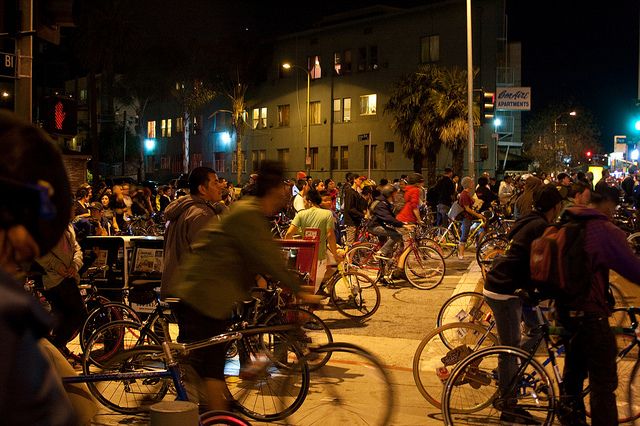Like bunny rabbits in Australia…
Like snakeheads on the Potomac River…
Like palm trees in Southern California…
This Sunday here in Los Angeles, on the catchy binary date of 10/10/10, another non-native species will presumably swamp clunkier competitors – at least between the hours of 10am-3pm.
The species: bicycles. The competitors: autos. The swamping: CicLAvia, the city’s first sanctioned go-around at closing a cross-neighborhoods swatch of streets to cars and trucks, and instead inviting Angelinos and visitors to come out and stroll, skate, bike and the like.
L.A.‘s path – mapped here – is set for 7.5 miles. The route extends from East Hollywood to East Los Angeles, and travels mostly along secondary roads and through diverse list of neighborhoods (Koreatown, Downtown, MacArthur Park, etc.).
CicLAvia organizers, a loose group of tenacious bike and planning activists and advocates, made certain that the route didn’t stray far from subway and light rail stations.
Joe Linton, author of this book and this blog, is a CicLAvia board member. “I think it’s going to be a blast,” Linton tells City / Culture. “People will experience Los Angeles in a way that they never have before.”
L.A. bike culture has been gaining rapidly, in tandem with a palpable discontent about automobile traffic bottlenecks and rising environmental awareness and obesity woes. Groups such as Midnight Ridazz and Critical Mass bring swarms of cyclists out on late-night streets. Bike Summits occur. DiY bike headquarters open. Furtive, sharrowed, wheat-pastes appear.
And while Sunday marks the city’s initial CicLAvia, it’s not the first time authorities cooperated in banning vehicles from roads. (This also happens during marathons and other such races.) In 2003, an approved event called ArroyoFest shut down a stretch of the historic 110 Freeway (nee, Arroyo Seco Parkway).
Robert Gottlieb was the organizer of that celebrated happening. He’s a professor at Occidental College, director of the Urban & Environmental Policy Institute, and co-author of this forthcoming book.
Given his ArroyoFest experience, what should CicLAvia participants expect this Sunday? “An incredibly liberating feeling,” Gottlieb tells City / Culture “of belonging to the streets and of escaping the continual presence and dominance of the car – its giant footprint, pollution, noise, and danger.”
Gottlieb, Linton, and others interviewed this week cite the ArroyoFest as a seminal precursor to this Sunday, but also note that the newer neighborhood route model is a long-sought upgrade over the Freeway closure model.
L.A.‘s CicLAvia has been two years in the planning, Linton says. He says supporters have donated $80,000, and the City another $120,000, towards making the day happen. (The Los Angeles Times puts the overall budget at $280,000.)
“I would stress that it’s a partnership – [our] non-profit is doing outreach, promotion, and event support, and city is doing closures. We’re really working together,” Linton says.
Linton also gives credit to Mayor Antonio Villaraigosa. “We were pushing for a while,” Linton says of CicLAvia planning, “and it wasn’t really real until he put his foot down and said, ‘This is happening!’”
Enthusiasm from past and former mayors has helped launch rides elsewhere. 2009 Next American Vanguard member Mike Lydon was a member of Miami’s Bicycle Action Committee and tells City/Culture how a presentation made by Bogotá‘s Enrique Peñalosa to Miami’s Manny Diaz helped birth Miami Bike Days. [Ed. note: Next week in this space, more from Lydon.]
Ciclovías – usually spelled sans the “LA” middle tag – have become en vogue internationally in great part thanks to the ongoing example set by Peñalosa et. al’s Bogotá. Not so long ago, that city was associated in the popular imagination mostly with the cocaine trade. Today, thanks in great part to its every-Sunday Ciclovía. Bogotá is synonymous with transformative urban planning. The Bogotá happening closes off ten times as many miles of streets as does Los Angeles’ fledging effort, and is said to draw two million people weekly.
According to research by Mike Lydon, Ottawa, Canada was the first North American city to embrace an “open streets initiative.” Ottawa got started in 1970. During the 38 years that followed, Lydon found that only six other cities on the continent followed suit. Then, from 2008-2010, 35 cities as well as the state of Kentucky joined in. Cities including Atlanta, Savannah, Kansas City, and Oakland are among burghs that debuted rides this year.
Opening up 7.5 miles of streets for five hours – as Los Angeles will do – is in itself an impressive achievement. That’s true even in a city where a single street can be 25-miles-long (try walking Sunset Boulevard), and where researchers have cataloged a whopping 914 miles of alleyways.
Still, organizers expect more will come from the CicLAvia. “I think that people see this as a one-day event,” Joe Linton says. “And though it’s going to be great day, it’s really about an ongoing program where, in the future, on some days in some places, we give our streets over to greener modes of transportation. I think that these temporary changes have the potential to permanently change the face of the city.”
UEPI’s Gottlieb, the ArroyoFest pioneer puts the challenge at hand like this: “L.A. appears so intractable in relation to car dominance,” he says. “But it also has advantages that make biking and walking potentially much more integral to the fabric of the city and the region: weather, topography, the multiple small cities, communities and neighborhoods with short distance-access to things one needs.”
Gottlieb also says: “As I like to quote Carey McWilliams, ‘L.A. is also the land of ‘magical improvisation,’ where we can reimagine a very different place.”
Next week: More with Mike Lydon – a Q&A with the principal of Street Plans Collaborative
Read past City / Culture columns here . Email the columnist at lathinktank [at] gmail [dot] org.



_920_518_600_350_80_s_c1.jpg)












